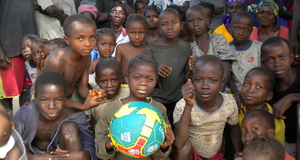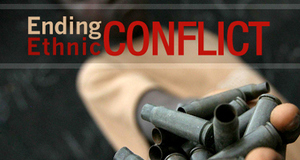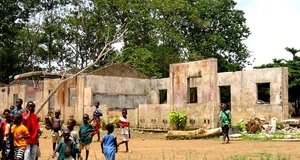From Retribution to Restoration in Sierra Leone: Fambul Tok's Drive to Heal Post-Civil Communities
By
2015, Vol. 7 No. 07 | pg. 1/1
IN THIS ARTICLE
KEYWORDS
Between 1991 and 2002, the small West African coastal state of Sierra Leone was rocked by a brutal civil war, which killed, injured, displaced, and traumatized millions of men, women, and children. In the aftermath of the conflict, local political elites combined with intergovernmental and nongovernmental organizations to establish the international-domestic Special Court for Sierra Leone (SCSL) and the Truth and Reconciliation Commission (TRC); they hoped that these hybrid bodies would respectively bring the war’s chief perpetrators to justice and address victims’ needs while creating a record of past atrocities for posterity. Unfortunately, many Sierra Leonean citizens criticized these high-level institutions for possessing more symbolic than practical value and crucially failing to repair rural communities ripped asunder by loss and suspicion. “The family tree bends, but it does not break.” - Sierra Leonean Proverb This paper examines the birth, growth, and work of a grassroots Sierra Leonean organization named Fambul Tok (“family talk” in the national language of Krio), which has attempted to compensate for the shortcomings of the SPSL and TRC by reviving ancient communal traditions of truth-telling, apology, and forgiveness. It demonstrates that the Fambul Tok model embraces many of the restorative justice paradigm’s core values and approaches, including its broad conception of harm, victim-centeredness, and bottom-up orientation; it argues that these facets account for the model’s overall effectiveness thus far. At the same time, though, this paper briefly addresses the limitations of the model at hand and makes recommendations as to how it could be modified to more effectively fulfill community needs in Sierra Leon and other parts of the African continent.Eleven Years of Acute TurmoilSierra Leonean communal traditions such as Fambul Tok were in decline long before the de facto commencement of civil strife. Jubilation at gaining independence from Great Britain in 1961—following one and a half centuries of colonial rule—quickly gave way to disenchantment with chronic political instability precipitated by successive military regimes (Sesay, 2014). “Decades of government mismanagement and corruption twinned with the strains of neoliberal structural adjustment, political repression within a single-party state, and the bankruptcy of institutions of justice and governance” (Park, 2010, p. 96) came to a head in 1991; the Revolutionary United Front (RUF)—a rebel militia comprised, in part, of fighters loyal to future Liberian president Charles Taylor—mobilized to seize control of the country. Importantly for the purposes of this paper, the RUF concentrated its attacks not on the national capital of Freetown but rather “isolated towns and villages… [and] farmers and artisanal diamond miners in rural areas” (Høiland, 2012, p. 33). Despite intermittent lulls in fighting and sporadic moves toward peace and democracy, “the war lingered on, fueled by power struggles and corruption within the government, intense criticism of the dubious rules played by private security agencies from South Africa and Britain, contested claims within the [diamond] mining industry [which funded and/or instigated much of the conflict], and the complicated role of the remaining RUF in negotiations with the seemingly revolving door central government” (Høiland, 2012, p. 33). Ordinary, rurally-based Sierra Leoneans bore the heaviest burdens imposed by these controversies and obstacles to a permanent cessation of hostilities: “10,000 children were captured [by military forces on both sides], tens of thousands of women and girls were raped, more than 2 million Sierra Leoneans were displaced from their homes and communities, and an estimated 10,000 suffered mass amputations” (Høiland, 2012, p. 33). Flawed Top-Down Legal Instruments for Postwar ReconstructionSierra Leone’s national government began disarming rebels and declared the war officially over between May of 2001 and January of 2002 (“Sierra Leone profile,” 2014). Seeking to prevent a relapse into chaos, it controversially offered all but a few of the war’s most notorious combatants blanket amnesty (Høiland, 2012, p. 33). With the backing of the United Nations, it then established the SCSL “to prosecute persons who bear the greatest responsibility for serious violations of international humanitarian law and Sierra Leonean law” (UN/Government of Sierra Leone as cited in Park, 2010, p. 97). Based out of Freetown, the SCSL tried to reach out to rural communities, with prosecutors traveling to the country’s many provinces to listen to grievances; it also endeavored to use its hybridity to strike a balance between local customs and international norms and established international legal milestones for the treatment of children and women in post-conflict societies (Park, 2010, pp. 98-99). However, many Sierra Leoneans criticized the court for indicting just thirteen men, a “puzzling” decision considering “the enormous scale of atrocities committed during the war” (Høiland, 2012, p. 33). They thus construed it as more of a symbolic gesture than a true vehicle for justice and an expensive symbol at that: the SCSL spent approximately $200 million on litigation (Høiland, 2012, p. 33), money that many believed “could be better used for other [public] objectives” (Fritz and Smith as cited in Park, 2010, p. 98). The Court additionally came under fire for only trying crimes perpetrated after 30 November 1996; having no jurisdiction over crimes committed by peacekeeper; and, for the most part, deliberating far away from the persons and communities most affected by the war (Park, 2010, p. 97). Needless to say, these sentiments echo critiques of the retributive justice paradigm as a whole, as articulated by Howard Zehr and other restorative justice scholars. Zehr contends that the criminal justice process neglects the needs of both victims and offenders, if not actively compounds their injuries (2005); in a similar vein, sociologist Augustine S.J. Park sees the SCSL’s perceived and actual failings as further proof that “adversarial processes are an obstacle to unveiling the truth, and trials are a barrier to narrating a shared history in which victims are vindicated, and through which reconciliation is made possible” (2010, p. 99). Possibly cognizant of the SCSL’s limitations, the Parliament of Sierra Leone established the TRC to ““create an impartial record of violations and abuses of human rights and international humanitarian law [and] to address impunity, to respond to the needs of victims, to promote healing and reconciliation, and to prevent a repetition of the violations and abuses suffered”” (qtd. in Høiland, 2012, p. 33). These goals are much more compatible with the restorative process; in fact, restorative theorists Mark Umbreit and Marilyn P. Armour hail the value of the South African TRC—upon which the Sierra Leonean commission was based—as “part of the healing process for victims of political violence” in diverse contexts (2011, p. 13). Furthermore, the Sierra Leonean TRC was successful—at least to a point—at fulfilling its self-described mission: not unlike the SCSL, it worked to be accessible to the general populace and explicitly sought to channel the voices of “women and girls, children, amputees, and ex-combatants” (Park, 2010, p. 100). Once again, though, Sierra Leoneans were underwhelmed by the TRC’s staffing, short-term focus, and removal from rural communities: they criticized local commissioners for their political affiliations and their international counterparts for failing to fully appreciate local conditions and challenges; they also chided its reluctance to conduct public hearings in any of Sierra Leone’s provinces for more than a week and alleged that it was more concerned with facilitating hasty truth-telling than fostering long-term reconciliation (Park, 2010, p. 100). Fambul Tok - “Discussing and Resolving Issues Within the Security of the Family Circle”Human rights activist John Caulker was one of many Sierra Leoneans frustrated by the SCSL and the TRC. He probably had more reason to be unsatisfied than most: as a member of the Truth and Reconciliation Commission Working Group (TRCWG), he made recommendations for the addition of a community justice component and the creation of mini-commissions in rural villages that were summarily dismissed by his peers (Høiland, 2012, p. 34). Exasperated and exhausted, he took a break from activism in the fall of 2007 to complete a human rights fellowship at Columbia University in New York City. While Caulker was in New York, Caulker met Elisabeth “Libby” Hoffman, the founder and president of Catalyst for Peace, a US-based private foundation that “mobilizes locally owned and locally led peace-building initiatives and then shares those stories with the world” (Høiland, 2012, p. 34). Even though they come from vastly different cultural, political, and socioeconomic backgrounds, Caulker and Hoffman both saw (and continue to see) the “immeasurable value of trusting the wisdom of communities [to build peace in a just way] rather than seeking to dictate solutions” (Høiland, 2012, p. 35). In contrast to the arguably imperialistic retributive interventionism endorsed by bodies like the UN, Hoffman posits that privileged persons and organizations should resist “the urge to swoop into poverty-stricken and war-torn areas [of Africa and the rest of the “Third World”] as “white saviors,”” instead supporting local solutions drawing upon local resources (Høiland, 2012, p. 35). In Caulker, Hoffman and Catalyst for Peace found “a home-grown leader who would be an ideal partner for developing peace-building programs in Sierra Leone” (Høiland, 2012, p. 35). In November of 2007, Caulker, Hoffman, and a few of their colleagues designed and established what would eventually become Fambul Tok International (FTI), with Caulker returning to Sierra Leone the following month to start implementing their ideas. They envisioned Fambul Tok as “a new, community-led approach to post-war reconstruction that walks alongside ordinary people [emphasis added], helping them reawaken cultural practices of acknowledgement, apology and forgiveness; rebuild their communities [emphasis added]; and lay the groundwork for development and sustainable peace” (Catalyst for Peace and Fambul Tok Sierra Leone, 2014). FTI prides itself on adopting a distinctly Sierra Leonean approach, “rooted not in western concepts of crime and punishment [emphasis added] but in communal African sensibilities that emphasize the need for communities to be whole—with each and every member playing a role” (Catalyst for Peace and Fambul Tok Sierra Leone, 2014). In practical terms, the organization helps village communities organize truth-telling bonfires and traditional cleansing ceremonies that give community members the opportunity to “come to terms with what happened during the war, to talk, to heal, and to chart a new path forward” (Catalyst for Peace and Fambul Tok Sierra Leone, 2014). Fambul Tok exemplifies the indigenous traditions upon which restorative justice as a whole is based (Umbreit & Armour, 2011, pp. 4-6): it simultaneously conceives of harm in an intimate, interpersonal sense as well as with respect to a broader community, seeking to repair damaged relationships between victims, offenders, and community members. The process parallels a number of better-known restorative approaches, in that it begins with an extensive consultation to ascertain the needs of different parties within a given community; prepares and trains these stakeholders in advance of reconciliation ceremonies, so as to give them the skills they need to pick up where FTI’s facilitators leave off; encourages facilitators to play relatively passive roles during the ceremonies themselves, foregrounding conversations between community members; and employs items and acts of symbolic value and spiritual significance to commence, punctuate, and conclude proceedings (Catalyst for Peace and Fambul Tok Sierra Leone, 2014). Bonfires make up the centerpiece of the Fambul Tok approach: held in the evening, they give victims and offenders a chance “to come forward for the first time to tell their stories, apologize, and ask for, or offer, forgiveness,” after which “communities…sing and dance in celebration of this open acknowledgement of and resolution to what happened in the war” (Catalyst for Peace and Fambul Tok Sierra Leone, 2014). Umbreit and Armour’s description of the restorative utilization of truth-telling holds true for the intended aims and self-professed outcomes of these bonfires: “when victims tell their story directly to the person responsible for their suffering, they, in effect, hold up a mirror that makes the impact of the crime real, tangible, and unforgettable”; on the other hand, “it is the offenders holding themselves accountable to those they have harmed that allows the victim to see their “human” face” (2014, pp. 55-56). As with peacemaking or sentencing circles, dialogue between victims and offenders is part of a public process, wherein “the integrity of the offender’s apology or response to the victim is judged by others to whom the offender is accountable for his or her future behavior including the completion of what needs to be done to make amends to the victim or community” (Umbreit & Armour, 2011, p. 56). Responsibility for ensuring that offenders act upon their purported remorse and satisfy their obligations ultimately lies with the community, but FTI’s staff members try to encourage follow-through by hosting a range of activities that strive to engage all community members. These events include the planting of peace trees, which serve as both leisurely gathering spots and future meeting places for community discussions; the cultivation of community farms, which provide community members with subsistence at the same time as they generate a little extra income; the creation of radio listening clubs, which seek to bring community members together for public discourse; and the organization of soccer matches, which particularly target and discourage fighting amongst youth affected by the war (Catalyst for Peace and Fambul Tok Sierra Leone, 2014). These sophisticated long-term peacebuilding and peace-maintenance strategies arguably have few institutional equivalents in Western restorative processes, possibly pointing to the depth of communality among rural Sierra Leoneans. At the same time, however, they recognize the difficulty of forgiving, especially for victims of violent crimes, and try to give victims, offenders, and community members as many opportunities as possible to get to know each other after their initial ceremonial interactions. Successes, Strengths, and Some Areas for ImprovementIn spite of Fambul Tok’s relatively modest beginnings, numerous Sierra Leoneans are requesting FTI’s assistance at present: during the first five years of its existence, the organization oversaw 155 reconciliation ceremonies during which over 2,700 people testified to over 60,000 neighbors and community members (Beyond Intractability); it is currently planning thousands more ceremonies in small clusters of villages across the country. Has Fambul Tok then been a complete success? If so, why? To a considerable extent, FTI’s growth and the popularity of its approach speaks to the latter’s efficacy. Testimonials from participants praise the model’s emphasis on community autonomy and cultural regeneration, non-punitive process orientation, provision of opportunities to laypersons for truth-telling, and sensitivity to the localized legacies of the war. One district youth chairman has gone so far as to claim that Fambul Tok “is the only project that will bring peace” to his and other communities (Catalyst for Peace and Fambul Tok Sierra Leone, 2014). Fambul Tok’s achievements thus far are partly attributable to the organization’s openness, reflexivity, and flexibility. While religion does not figure into FTI’s approach per se, administrators recognize that most rural Sierra Leoneans are very devout; staff members plan ceremonies according to local Muslim, Christian, and/or indigenous customs and endeavor to ensure that ceremonies fairly represent all faiths and other local demographic factors (Høiland, 2012, p. 36). FTI tries to be as sensitive to gendered differences in wartime experience as it is to religious and spiritual particularities at play. Not long after they began their work, FTI’s leaders noticed that some women were not telling their stories at bonfires while others who did occasionally regretted their decision to participate: they felt as though their communities did not want to hear their accounts of sexual violence and/or ridiculed them when they did share their wartime travails (Cole and Norander, 2011, p. 35). To address this conundrum, Fambul Tok brought together women from around the country to discuss how the organization could support women’s participation in reconciliation activities; after meeting as a group, the women decided to call themselves “Peace Mothers,” looking forward “by referencing peace…which acknowledging the vital role that women play, as mothers, in Sierra Leonean communities” (Cole and Norander, 2011, p. 35). Many Peace Mothers have garnered respect from the men in their communities for farming and organizing seed and harvest exchanges, with minimal assistance from Fambul Tok. Caulker admits that, although he didn’t realize it at the beginning, “women are really key to Fambul Tok,” which is making “gender mainstreaming an important focus of [its] work” (Cole and Norander, 2011, p. 36). The case of the Peace Mothers shows that FTI’s administrators would probably be the first parties to acknowledge their model’s limitations, some of which continue to affect their operations. Select participant testimonies suggest that provincial chiefs wield strong influence over Sierra Leonean communities; Fambul Tok facilitators typically solicit their permission to carry out ceremonies in their jurisdictions (Catalyst for Peace and Fambul Tok Sierra Leone, 2014). Given that the denial of permission, however uncommon, would deny community members access to reconciliation, Fambul Tok might want to consider offering more individualized restorative options, such as victim-offender mediation or dialogue or family group conferencing. These alternatives could pave the way to engagement with problematic chiefdoms, as citizens who benefit from Fambul Tok might rally to bring FTI to their communities; they could also channel the voices of women or other vulnerable community members unwilling to speak before large crowds. Caulker and Hoffman additionally recognize that their organization, what with its overseas donors and American headquarters—shares an innately imbalanced relationship with its community partners (Cole and Norander, 2011, p. 45); as long as they keep this recognition in mind and do not indiscriminately distribute funds and resources, they should be able to avoid fomenting an unhealthy and unsustainable dependency complex among participating villages. The Future of “Family Talk”Since it burst onto the scene in 2007, Fambul Tok has “generated a substantial amount of interest throughout Africa,” having been contacted by “individuals and organizations from Liberia, Guinea, Uganda, Kenya, Zimbabwe and others inquiring about the applicability of the… model in those settings” (Catalyst for Peace and Fambul Tok Sierra Leone, 2014). Clearly, more and more African persons and communities are acknowledging the failures of the retributive approach—often a holdover from the colonial era—and turning to Fambul Tok as a viable restorative alternative. As long as FTI remembers its roots and indebtedness to the thousands of courageous Sierra Leoneans who have made the model work, it could play a vital role in addressing the social rifts that have plagued modern Africa for decades—one bonfire at a time. ReferencesBeyond Intractability. (n.d.). Love and forgiveness in governance: exemplars: Fambul Tok. Beyond Intractability. Retrieved October 21, 2014 from http://www.beyondintractability.org/lfg/exemplars/fambultok Catalyst for Peace and Fambul Tok Sierra Leone. (2014). Fambul Tok. Retrieved October 21, 2014 from http://www.fambultok.org/ Cole, C. & Norander, S. (2011). From Sierra Leone to Kosovo: exploring possibilities for gendered peacebuilding. Women & Language, 34(1), 29-49. Hoffman, L., Kennedy, R. & Terry, S. (Producers) & Terry, S. (2011). Fambul Tok [Motion Picture]. United States: Circus Road Films. Høiland, T. (2012, July). A more sustainable peace: healing comes to Sierra Leone, thanks to the Fambul Tok movement of community-led reconciliation. Prism Magazine, 32-37. Lofton, B. (2014, June 22). Fambul Tok helps heal Sierra Leone. EMU News. Retrieved from http://emu.edu/now/peacebuilder/2014/08/fambul-tok-helps-heal-sierra-leone/ Park, A. (2010). Community-based restorative transitional justice in Sierra Leone. Contemporary Justice Review, 13(1), 95-119. Sesay, S. (2014). Sierra Leone. Encyclopaedia Britannica Online. Web. Retrieved October 21, 2014 from http://global.britannica.com/place/Sierra-Leone. Sierra Leone profile - Timeline. (2014, September 18). BBC News. Retrieved December 12, 2014 from http://www.bbc.co.uk/news/world-africa-14094194 Umbreit, M. & Armour, M.P. (2011). Restorative Justice Dialogue: An Essential Guide for Research and Practice. New York, NY: Springer Publishing Company. Zehr, H. (2005). Changing Lenses: A New Focus for Crime and Justice (3rd ed.). Scottdale, PA: Herald Press. Suggested Reading from Inquiries Journal
Inquiries Journal provides undergraduate and graduate students around the world a platform for the wide dissemination of academic work over a range of core disciplines. Representing the work of students from hundreds of institutions around the globe, Inquiries Journal's large database of academic articles is completely free. Learn more | Blog | Submit Latest in International Affairs |


















